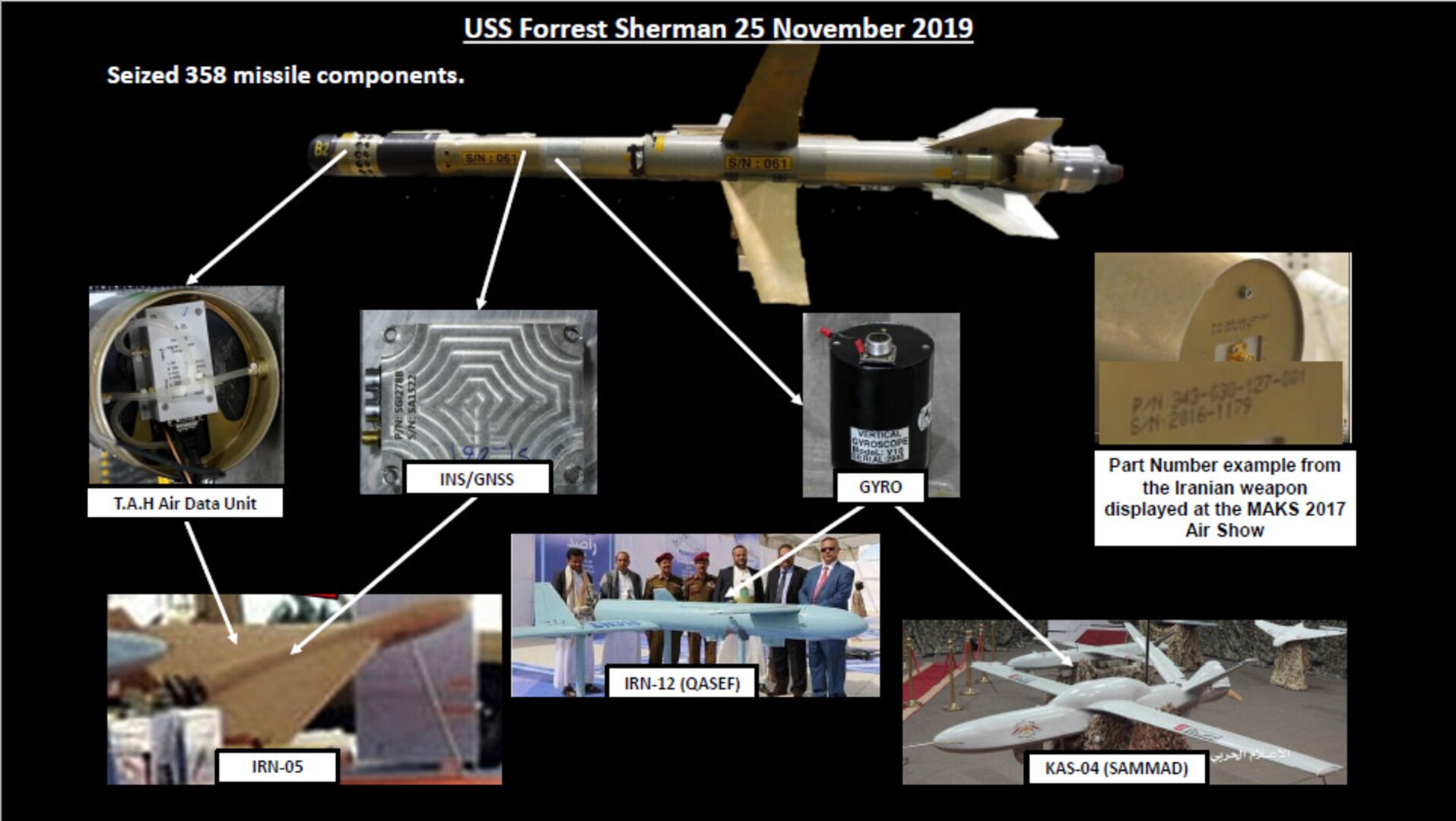
One of the five, near-fully assembled uniquely Iranian-designed and manufactured Three-Five-Eight surface-to-air missiles that were a part of the shipment seized by the USS FORREST SHERMAN in November (2019).
“… It seems that Iran has transferred this type of missile to its allies in Yemen to test it against the American planes owned by the Saudi and Emirati air forces participating in the war…”
The Iranian “358” missile appears to be an increasingly important weapon for Yemen’s Houthi-led military forces. The 358 missile is classified as surface-to-air, but in early January, it was seemingly used as a surface-to-surface missile to target the provincial leader of the pro-secessionist Southern Transitional Council (STC) in Shabwah Province. On 14 January, a 358 was used to shoot down a Chinese-manufactured Wing Loong II unmanned aerial vehicle (UAV) belonging to the Saudi-led coalition, according to several open-source analysts on Twitter. It is unclear how many of these missiles are in Houthi possession. Since 2019, several of them have been seized from Yemen-bound vessels in the Arabian Sea. A 358 was also found in Iraq last October.
According to an October 2021 article from the prominent Yemeni news website al-Masdar Online, the 358is a key Iranian weapon developed to counter U.S. aircraft, particularly UAVs. The missile ships in three parts and once assembled can be launched from mobile positions, such as small trucks. It does poorly against fast-moving targets but can be effective against helicopters and some UAVs. The article from al-Masdar Online implies that it may be the Houthi-led military forces’ most effective air defense missile, potentially having been used to bring down a variety of aircraft, including an Apache helicopter, Wing Loong UAVs, Scan Eagle and RQ-20 UAVs manufactured by the United States, and the Karayel UAV manufactured by Turkey. This sentiment is echoed by analysis from the Egyptian think tank Egyptian Center for Strategic Studies, which considers the 358’s presence in Yemen and Iraq as indicative of “a new shift in Tehran’s strategy in using its proxies in the region,” one which puts new emphasis on defending against aerial attacks.
Source:
@3Mr_o_o (pro-Houthi, Iraq-based “Observer of political and military affairs”), Twitter, 3 January 2022. https://twitter.com/3Mr_o_o/status/1478359982097813511
#Yemen
The mercenary Ali al-Jabwani, head of the Transitional Council in Shabwa governorate, survived an attack in the Usaylan area yesterday. The images released from the attack show a missile similar to the famous 358 missile.
Source: @AlgerianAircra1 (Algeria-focused “Aircraft Tracker” account interested in “Aircraft News and Novelties related to Defense and Aviation”), Twitter, 14 January 2022. https://twitter.com/AlgerianAircra1/status/1481988325774925825
It appears that the Houthis in Yemen have shot down another Wing Loong II UCAF aircraft from the Saudi coalition. Judging by the video, it seems that an Iranian missile known as the 358 was used – a large, relatively slow missile with large wings.
Source:
“من “صلاح الدين” العراقية الى “مارب” اليمنية.. صواريخ دفاع جوي إيرانية بأيدي مليشيات طهران
(From Iraq’s Salahuddin to Yemen’s Marib… Iranian Air Defense Missiles in the Hands of Tehran’s Militias),” al-Masdar Online (prominent Yemeni news website), 24 October 2021. https://almasdaronline.com/articles/239284
But the situation has changed significantly since mid-2019, when the Houthi militia announced in June that its air defenses had managed to shoot down a U.S.-made MQ9 drone in Hodeidah Governorate, using a “domestically developed” missile. In August of the same year, the militia’s military spokesman said: “We have the ability to neutralize a large number of enemy aircraft.”… It seems that Iran has transferred this type of missile to its allies in Yemen to test it against the American planes owned by the Saudi and Emirati air forces participating in the war. Iran considers this missile as its armor against American aircraft…
Source:
“تهديد الأجواء.. ما وراء حائط الصواريخ الإيراني في الشرق الأوسط
(Threat to the skies… Behind the Iranian missile wall in the Middle East),” Egyptian Center for Strategic Studies (Egyptian think tank), 2 November 2021. https://marsad.ecss.com.eg/64307/
The unique design of this missile, and its subsequent reappearance in other regions in the Middle East, was an indication that it might be the main player in all the shootdowns that have taken place in Yemen recently, such as the downing of a “Scan Eagle” drone last June, in Serwah District, Marib Governorate … In sum, the appearance of the “358” missile in Iraq, and before that in Yemen (and it may have been used recently in Syria), indicates a new shift in Tehran’s strategy in using its proxies in the region. This strategy now includes air defense, after it was previously limited to missile power, and then drones.
Image Information:
Image: One of the five, near-fully assembled uniquely Iranian-designed and manufactured Three-Five-Eight surface-to-air missiles that were a part of the shipment seized by the USS FORREST SHERMAN in November (2019).
Source: CENCTCOM, Steve McLeod, https://www.centcom.mil/MEDIA/NEWS-ARTICLES/News-Article-View/Article/2087998/us-dhow-interdictions/
Attribution: Public Domain
